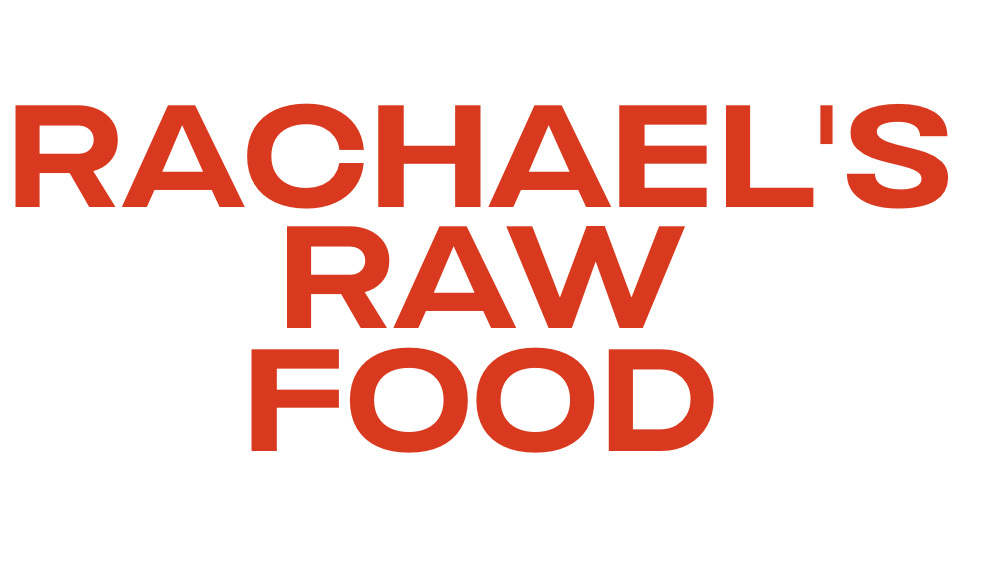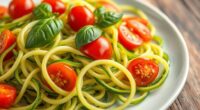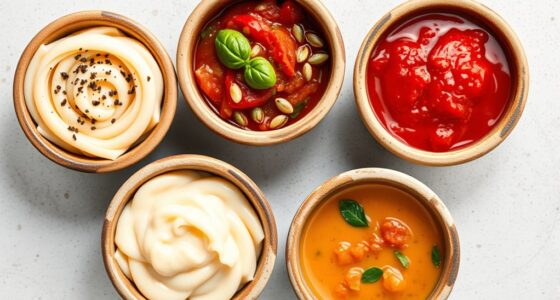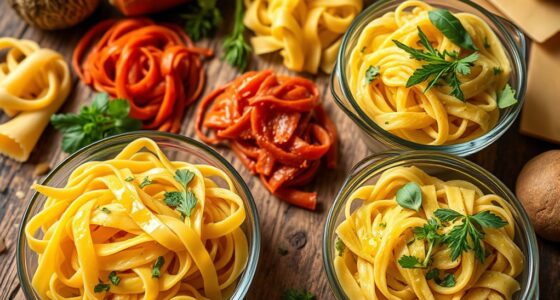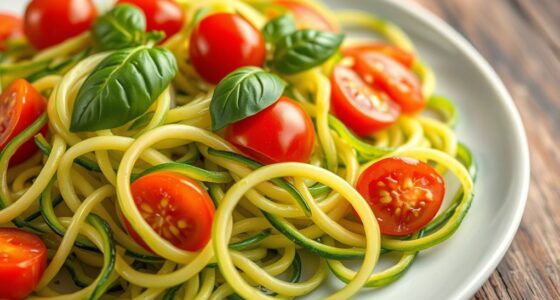Kelp noodles are a healthy, eco-friendly alternative to pasta made from nutrient-rich seaweed. They’re gluten-free, low in calories, and packed with iodine, calcium, and vitamins, making them great for boosting your nutrient intake. Their chewy texture adds variety to salads, stir-fries, and cold dishes, while their subtle ocean flavor pairs well with many ingredients. Want to know how to incorporate them into your meals? Keep exploring to discover how versatile and beneficial these noodles can be.
Key Takeaways
- Kelp noodles are made from sustainably farmed seaweed, offering a gluten-free, low-calorie pasta alternative.
- They are rich in nutrients like iodine, calcium, magnesium, and vitamins A, C, and K, supporting overall health.
- With a chewy texture, they absorb flavors well and are versatile for salads, stir-fries, and cold dishes.
- Suitable for various diets, they promote weight management, blood sugar control, and healthy digestion.
- Their production supports environmental sustainability, reducing carbon footprint and ocean health benefits.
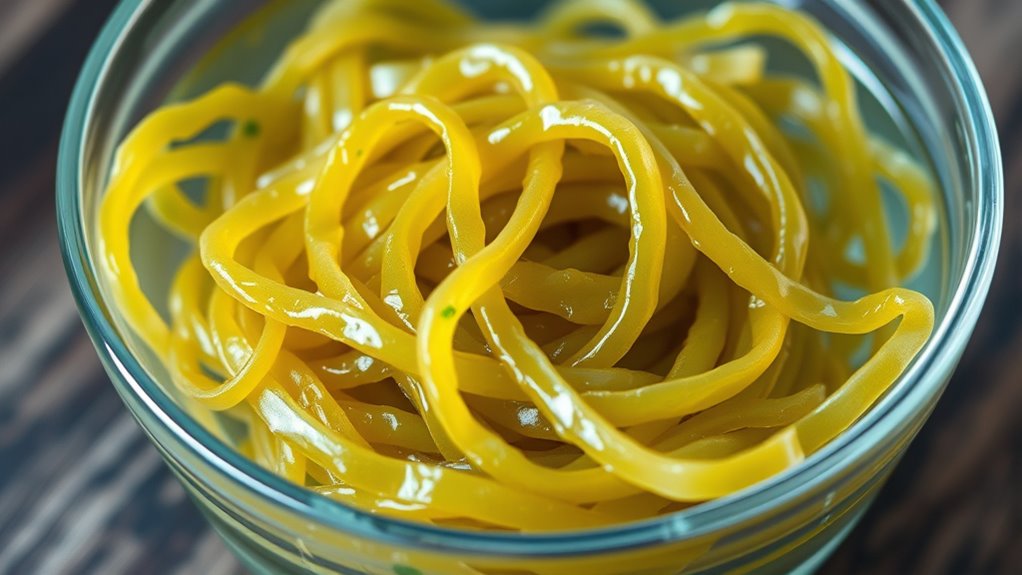
Kelp noodles are a popular gluten-free, low-calorie alternative to traditional pasta made from thin strands of kelp seaweed. When you explore these noodles, it’s helpful to understand how they’re produced and why they’re a nutritious choice. Seaweed farming plays an essential role in creating kelp noodles, as sustainable cultivation methods ensure high-quality seaweed that’s free from contaminants. Farmers typically grow kelp in coastal waters, harnessing its natural ability to thrive in nutrient-rich environments. This farming process not only supports the environment but also guarantees a steady supply of fresh, organic seaweed for making noodles. The sustainability of seaweed farming makes kelp noodles an eco-friendly option that aligns with health-conscious and environmentally aware lifestyles.
Beyond the farming process, the nutritional benefits of kelp noodles stand out, making them an appealing addition to your diet. Kelp is packed with essential nutrients, including iodine, calcium, magnesium, and vitamins A, C, and K. Iodine, in particular, is necessary for healthy thyroid function, and since many diets lack sufficient amounts, kelp noodles provide a natural way to boost your intake. Additionally, kelp contains antioxidants and dietary fiber, which support digestion and help maintain overall health. Because kelp noodles are low in calories and carbohydrates, they’re ideal if you’re watching your weight or managing blood sugar levels. Their chewy texture adds a satisfying element to meals without adding excess calories or gluten, making them suitable for various dietary restrictions.
When you incorporate kelp noodles into your meals, you benefit from their versatility and nutritional punch. They absorb flavors well, so you can toss them into salads, stir-fries, or cold noodle dishes with ease. Their mild, oceanic taste pairs nicely with a variety of ingredients, from sesame and soy to lemon and herbs. As you explore these noodles, you’ll notice how their natural nutrients complement a balanced diet, helping you feel full and energized. Plus, since kelp farming is environmentally sustainable, choosing kelp noodles supports ocean health and reduces your carbon footprint compared to traditional pasta options.
Frequently Asked Questions
Are Kelp Noodles Suitable for a Low-Sodium Diet?
If you’re wondering whether kelp noodles suit a low-sodium diet, the answer is yes. They naturally contain very little sodium, making them an excellent choice for reducing salt intake. Incorporating kelp noodles can contribute to your health benefits by supporting heart health and managing blood pressure. You can enjoy their chewy texture without worrying about excess sodium, making them a smart addition to your low-sodium meal plan.
How Long Do Kelp Noodles Last in Storage?
Wondering how long kelp noodles stay good in your fridge? You can expect a storage duration of about 5 to 7 days if kept submerged in water and stored in an airtight container. To preserve their freshness, change the water daily and keep them chilled. For ideal freshness preservation, consume them sooner rather than later, as extended storage can affect texture and taste.
Can Kelp Noodles Be Cooked or Only Eaten Raw?
You can cook kelp noodles if you prefer a softer texture or want to explore different flavor variations. Simply rinse and simmer them for a few minutes, which enhances their taste and makes them more palatable. Cooking methods like boiling or stir-frying work well, but many enjoy eating kelp noodles raw for their chewy texture and nutritional benefits. Feel free to experiment to find your favorite way to enjoy them.
Are Kelp Noodles Gluten-Free and Vegan?
Yes, kelp noodles are gluten-free and vegan. They typically have a gluten-free certification, ensuring they’re safe for gluten-sensitive individuals. Their vegan ingredient list usually contains only kelp, water, and sometimes a preservative, making them suitable for plant-based diets. You can enjoy kelp noodles without worry about gluten or animal products, making them a versatile, healthy choice for many dietary needs.
Do Kelp Noodles Contain Any Added Preservatives or Additives?
Imagine biting into kelp noodles, feeling their firm, chewy texture. You’ll find they’re typically made from preservative-free ingredients, meaning no added preservatives or additives. Most brands prioritize simplicity, so concern over additives diminishes. Just check the label to guarantee it’s free from hidden chemicals. With minimal ingredients, you get a natural, healthy option that aligns with your desire for clean, additive-free foods.
Conclusion
Now that you know the ins and outs of kelp noodles, you’re ready to give them a whirl in your kitchen. Think of them as your modern-day al dente pasta, but made from the ocean’s bounty. With a simple rinse and your favorite toppings, you’ll have a nutritious, chewy alternative that’s perfect for any meal. So, grab your wooden spoon and plunge into—just like a pioneering explorer discovering new flavors in uncharted waters.
